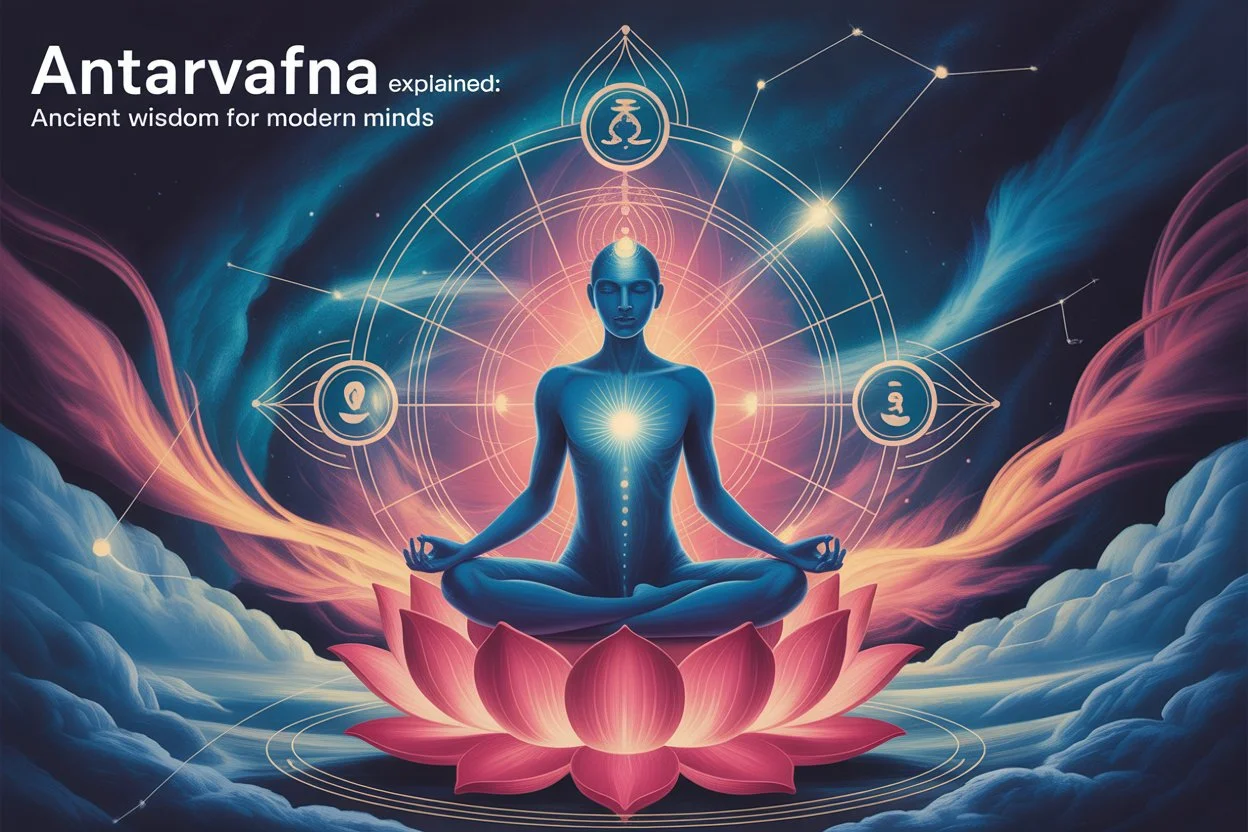Introduction : Why Antarvafna Matters Today
Life today moves fast. We scroll, tap, and switch from one task to another. Distractions surround us everywhere. In this restless pace, moments of silence feel rare. Yet silence and reflection are what our minds need most.
This is where antarvafna enters the picture. The word comes from Sanskrit. “Antar” means within. “Vafna” refers to struggle or perception. Together, antarvafna means the practice of looking inward with awareness. It is the art of watching thoughts and feelings without judgment. It is the skill of noticing patterns before reacting.
Why does this matter today? Because our world is filled with noise. Social media urges us to compare. Work pressures push us to rush decisions. Stress builds when we ignore our inner conflicts. Antarvafna offers the opposite. It gives us space to reflect. It helps us understand what is happening inside.
Through this practice, we discover clarity in chaos. We find wisdom in silence. We start responding sensibly instead of rashly. Ancient sages used antarvafna to reach balance and peace. Today, we can use it to handle stress, improve focus, and live authentically.
In short, antarvafna matters because it connects two worlds. It carries the wisdom of ancient philosophy. At the same time, it offers tools for modern challenges. With it, we can slow down, see clearly, and live with purpose.
What Is Antarvafna?
The word antarvafna comes from Sanskrit roots. “Antar” means within, and “vafna” means struggle or perception. Together, the term describes the process of turning inward. It reflects the quiet yet powerful battle of thoughts, emotions, and desires inside us.
Unlike ordinary mindfulness, antarvafna is not only about calming the mind. Instead, it is about facing inner conflict with openness. It teaches us to observe our feelings without fear. It guides us to notice patterns that shape our decisions.
This awareness goes beyond relaxation. It encourages growth, authenticity, and clarity. While mindfulness helps us stay present, antarvafna helps us understand why we feel, think, or act a certain way. Therefore, it becomes a deeper journey of reflection, guiding us toward balance and wisdom.
Antarvafna in Ancient Wisdom Traditions
Antarvafna has deep roots in India’s ancient wisdom. It appears in Hindu, Buddhist, and Jain philosophies. Each tradition explains it in its own way, yet the core idea remains the same—looking inward to resolve conflict and find clarity.
In Hinduism, antarvafna often means the struggle between dharma and desire. The Bhagavad Gita shares the famous story of Arjuna. On the battlefield, he faced a painful inner conflict. Should he fight against his family or abandon his duty? His confusion reflects the true essence of antarvafna.
Lord Krishna’s guidance shows us the path forward. He taught that clarity comes through awareness, and true freedom lies in following dharma.
Buddhism views antarvafna as the tension between attachment and liberation. Through meditation, one learns to release cravings and move toward Nirvana. Jainism connects it to the battle of the soul against karma and worldly temptation.
Together, these traditions remind us that inner struggle is universal. They teach us that facing conflict with awareness does not weaken us. Instead, it helps us make wise choices and live with balance.
Antarvafna in Modern Psychology and Daily Life
Modern psychology offers new ways to understand antarvafna. It closely connects to cognitive dissonance, a term describing mental discomfort when thoughts and actions conflict. This discomfort can create stress, but it also pushes us toward change. Antarvafna helps us recognize these conflicts and respond with awareness.
Through this practice, we build stronger self-awareness. We notice hidden beliefs, emotional triggers, and automatic reactions. By observing them, we reduce stress and calm anxiety. It also lessens overthinking by giving the mind space to pause and reflect.
In daily life, antarvafna plays many roles. When making decisions, it helps us choose long-term values over short-term impulses. Within relationships, the practice creates empathy and reduces miscommunication. As for leadership, it fosters clarity, resilience, and ethical choices.
Therefore, antarvafna is not just ancient wisdom. It is also a modern tool for healthier minds, stronger connections, and wiser living.
Key Benefits of Practicing Antarvafna
Practicing antarvafna brings many life-changing benefits. First, it develops emotional balance. By observing our feelings calmly, we respond with patience instead of reacting impulsively. This builds resilience and helps us recover faster from challenges.
Second, it sharpens focus and clarity. In a world full of distractions, antarvafna clears mental fog. It allows us to see priorities clearly and make wiser choices. Decisions become less rushed and more thoughtful.
Third, it strengthens relationships. By reflecting on our emotions, we understand others better. This builds empathy, improves communication, and creates authentic connections. Trust grows when we act with awareness.
Finally, antarvafna supports long-term growth and peace. With regular practice, stress reduces and inner calm increases. Over time, it creates a strong sense of purpose and authentic living.
Thus, antarvafna is more than reflection—it is a pathway to a balanced and fulfilling life.
How to Practice Antarvafna Every Day
Practicing antarvafna daily does not require big changes. Small, consistent steps are enough. Start with mindful breathing. Take a few minutes to notice each inhale and exhale. This simple habit brings calm and focus.
Next, try journaling. Write down your thoughts and feelings without judgment. Over time, patterns will appear. These insights help you understand emotions and choices more clearly.
Self-reflection is another key step. Set aside quiet moments to observe your inner world. Ask yourself why you feel a certain way. This builds awareness and reduces impulsive reactions.
Practical tips make antarvafna easier. Do a short morning check-in before using your phone. Practice mindful walking by focusing on each step and your surroundings. Use visualization to imagine challenges and observe your emotional responses.
Most importantly, remember consistency matters more than duration. Even five minutes daily can create lasting change.
Common Misconceptions About Antarvafna
Many people misunderstand antarvafna. One common myth is that it is only for spiritual seekers. In truth, anyone can practice it. Students, professionals, and leaders all benefit from inner reflection. It is not limited to monks or philosophers.
Another misconception is that antarvafna means emptying the mind. Instead, it is about observing thoughts without judgment. The mind will always create thoughts. The goal is to notice them and learn, not erase them.
Finally, some people believe discomfort is failure. Yet, facing discomfort is part of growth. Hidden fears and emotions surface during reflection. While this feels challenging, it is also healing. By walking through these struggles, we become stronger and wiser.
Thus, antarvafna is practical, inclusive, and deeply human. It is about awareness, not perfection.
Challenges and How to Overcome Them
Like any practice, antarvafna comes with challenges. Restlessness is very common. Sitting quietly can feel uncomfortable at first. The mind wants to wander or escape. Instead of resisting, gently return attention to your breath or thoughts.
Self-criticism is another obstacle. Many people judge themselves harshly during reflection. However, antarvafna is not about perfection. It is about observing with kindness. Remind yourself that every thought is part of learning.
Impatience also creates difficulty. Growth takes time, and progress is often slow. Yet, consistency brings results. A few minutes daily is more valuable than rare long sessions.
Support also makes the journey easier. Community groups, mentors, or even professional guidance provide encouragement. Sharing struggles and insights reduces isolation. With compassion, patience, and support, challenges become stepping stones toward deeper awareness.
Why the World Needs Antarvafna Now More Than Ever
Modern life moves at a relentless speed. Information floods our minds every second. Stress and distractions follow us from home to work. As a result, many feel overwhelmed and disconnected.
This is where antarvafna becomes vital. It works like a reset button for the mind. By turning inward, we pause the noise of the outside world. Each moment of reflection clears confusion and restores balance.
Moreover, its relevance goes far beyond culture or profession. Leaders, students, parents, and workers can all benefit equally. Whether facing career pressure or personal struggles, the practice builds clarity and strength.
Ultimately, the world needs antarvafna because it restores what we’ve lost—presence, calm, and inner wisdom. It is timeless guidance for today’s chaotic times.
Conclusion : Choose Reflection Over Reaction
Antarvafna bridges ancient wisdom with today’s urgent needs. It guides us through noise and confusion. By practicing reflection, we gain clarity instead of reacting impulsively.
Starting small is the best way forward. Even a few mindful minutes create change. With patience and consistency, the benefits multiply over time.
Remember, antarvafna is not just a practice. It is a lifestyle that nurtures awareness, balance, and peace. Anyone, regardless of age or background, can embrace it daily.
So choose reflection over reaction. Choose calm over chaos. Begin your journey with antarvafna today. Your inner world holds the strength you seek.

